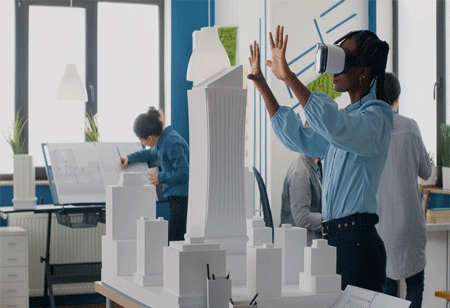
Architecture of all the arts is the one which acts most slowly, but more surely on the soul – Ernest Dimmet
Today’s modern man or Homo Sapiens has come through a series of thriving decade which made them strong, intelligent and skillful. Yesterday’s hunter-gatherers and cave dwellers are constructing skyscrapers using cutting–edge tools and machines. Ever since human started to form societies and giving shape to their world, a particular art form known as architecture has existed. From the inception of human, a clear idea of art was already there which was exhibited through the ancient cave paintings and stone art. Those cave art is so uniquely beautiful that we have been adopting the style through our art and culture till date, by blending it homogenously with modern art.
Architecture has changed the foundation of civilization. Vigorous efforts of humans to have a cozy comfortable and pragmatic life have invested a lot of techniques. Many layers of dexterity have been unveiled till date in construction industry and the 3D Architectural visualization is one of the brightest stars among them. The concept of 3D architectural design is the latest addition in the modern art and architecture.
What is 3d Modeling and 3D Visualization?
3D modeling is the process of creating three-dimensional representations of an object or surface using computer-based 3D modeling software. 3D visualization is a trend in architecture that has dictated the art form for a while now. It is the process where you can take your architectural design, or any other design, and present it in a 3D environment. The drawing on paper to bring your idea to life is long gone now, but today’s technologically advanced decade has been experiencing the advanced architecture as simple, streamlined, and straightforward as possible. 3D visualization is not only helping the architects but helping the home-buyers in communicating their ideas, no matter how solid or abstract it is. Technology is enabling the construction industry to achieve more in lesser time with reduced cost. Tradition and culture has dictated the trends in architecture from the time immemorial, but now with changing time, trends are dictating how the architecture looks, and the technology drives how the work is conducted itself.
Significance of 3D modeling and visualization in Architecture
Construction 3D Printing
It is a brand new technology in construction and building industry, which has already replaced hard manual labors with a machine that creates and assembles structures. It is an astoundingly cost-effective, convenient and environmentally sound way to construct new buildings. It provides you the benefits of 3D printing in construction and helping the architects to streamline their workflow towards the greatest customer satisfaction. Construction 3D printing includes the methods of producing construction elements by using 3D printer printing concrete, polymer, metal, or other materials, layer-by-layer. Concrete 3D printing in the construction industry helps to save time, effort, and material compared to the traditional construction methods. A 3D printer will dispense a paste-like mixture which includes cement blend, sometimes bio-resins, like soil, clay or wood flour, which is fine sawdust mixed with a corn-based binder.
The robotic arm extruder referred to as contour crafting is using an arm or crane-like structure that moves back and forth, to release materials and create layers. This Robotic arm extruder method is commonly used in case of smaller 3D printing activities.
In sand layer method the 3D printer releases fine layers of sand to build structures. When the thickness of the layer reaches to the desired level the machine releases droplets that harden and bind the sand. This method is used for smaller structures or materials in construction.
3D printing technology with other technology such as powder binding and additive welding is used to create structures such as bridges that might not have a foundation.
Market Demand
The global market of 3D modeling, 3D visualization and 3D data capture was valued worth $780.6 million in 2021, and it will grow till $1.1 billion by 2031 exhibiting a CAGR of 4 percent. The increasing level of penetration of advanced technologies like Artificial Intelligence, Machine Learning AR and VR has been upscaling the market demand of this method. The 3D Architecture Software Market size is expected to be worth around USD 7.7 billion by 2032 from USD 2.5 billion in 2022, growing at a CAGR of 12 percent during the forecast period from 2022 to 2032. The most popular software for creating 3D models in this manner are 3ds Max, Blender,Maya, Tinkercad, Vectary and Meshmixer.
Future outlook
As the days are progressing, people are getting more aware of the good health of the Mother earth and safeguarding the nature. We are frequently searching for innovative ideas and methods which can cater our requirements and demands and at the same time work with efficiency and effectiveness and accelerate the pace of progress. Undoubtedly, the introduction of 3D concept in real estate and construction industry has triggered the growth of this sector and unveiled new horizons of architectural concept design. 3D modeling and construction 3D printing techniques are doing great towards sustainability by recycling and minimizing the effects of pollution. These cutting-edge highly advanced methods generate less waste than any other conventional construction sites. 3D printers create lattice patterns with materials, so recycled plastic can create a sturdy structure.
It does not require much human interference, which means it provides high-end production without having the risks of too many accidents related to construction sites. Undoubtedly, 3D concepts have brought a revolution in construction industry but, many workers and builders are negligent to adopt this new concepts instead they love to stick to the traditional and conventional method of construction because of having no proper training. Hopefully in coming days, more such concepts will come and effectively redefine the balance sheet of the construction industry.
We use cookies to ensure you get the best experience on our website. Read more...
Copyright © 2025 HomesIndiaMagazine. All Rights Reserved.